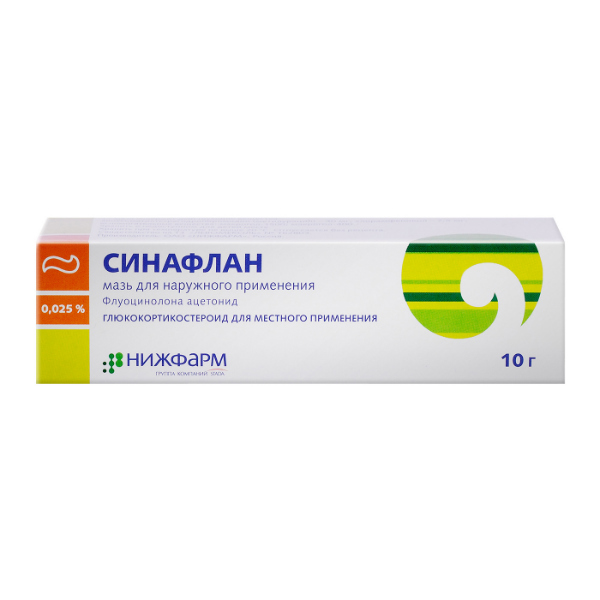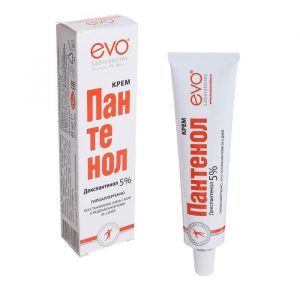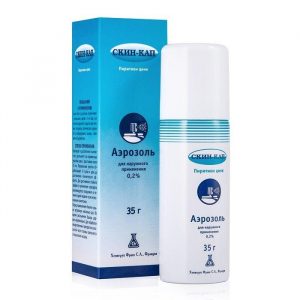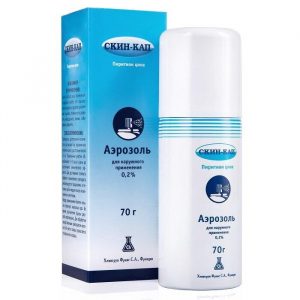Description
Latin name
Sinaflan ointment
Release form
Ointment for external use.
Packaging
Tube 10 g.
Pharmacological action
Glucocorticosteroid for external use. It has anti-inflammatory, anti-allergic, anti-exudative and antipruritic effects. Reduces manifestations and eliminates the inflammatory skin reaction.
Pharmacokinetics
After absorption from the skin surface, it binds to plasma proteins, is metabolized in the liver with the formation of inactive metabolites. It is excreted mainly by the kidneys.
Indications
Eczema, atopic dermatitis, simple chronic lichen (limited neurodermatitis), toxidermia, simple allergic dermatitis, seborrheic dermatitis, pruritus, urticaria, pruritus, diaper rash, multiforme exudative erythema redis, psoriasis, flat psoriasis, flat psoriasis, flat psoriasis lupus, dyshidrosis of the hands, otitis externa, burns of the 1st century, insect bites.
Contraindications
Hypersensitivity to the drug’s components bacterial, viral, fungal skin diseases – pyoderma, chickenpox, herpes, actinomycosis, blastomycosis, sporotrichosis skin manifestations of syphilis, tuberculosis of the skin, diaper rash, rosary erythematosus, rosary erythematosus, rosary cornea, itching trophic ulcers of the lower leg associated with varicose veins, erosive and ulcerative lesions of the gastrointestinal tract, wounds in the areas of applications skin cancer, nevus, atheroma, melanoma, ge Angioma, xanthoma, sarcoma, pregnancy and lactation, children’s age (up to 2 years).
Use with caution in girls during puberty.
Composition of
1 g of ointment contains: active ingredient: fluocinolone acetonide (sinaflan) – 0.25 mg, excipients: propylene glycol – 49.75 mg, ceresin – 50.00 mg, lanolin – 50.00 mg, petrolatum – up to 1.0 g
Dosage and Administration
Externally. Pre-wiped with a swab moistened with antiseptic liquid, a small amount of the drug is applied 2-4 times a day and rubbed lightly. If necessary, an occlusive dressing can be applied, leaving it on the affected surface for up to 3-4 days. It is not allowed to apply under a bandage more than 2 g per day. The duration of treatment depends on the nature of the disease and is usually 5-10 days, with a long course of the disease up to 25 days.
Ointment is preferable to use for dry forms of dermatoses.
Side effects
It is possible to develop secondary infectious lesions of the skin and atrophic changes in it (burning, skin itching, dry skin, steroid acne, folliculitis). With prolonged use – hypertrichosis, alopecia, especially in women, secondary immunodeficiency (exacerbation of chronic infectious diseases, generalization of the infectious
process, development of opportunistic infections), skin atrophy, local hirsutism, telangiectasia, purpura, pigmentation disorder. When applied to vast surfaces, systemic manifestations are possible (gastritis, “steroid” gastric ulcer, adrenal insufficiency, Itsenko-Cushing’s syndrome, “steroid” diabetes mellitus, slowing down of reparative processes).
Drug Interaction
Compatible with antimicrobials. Reduces the activity of antihypertensive, diuretic, antiarrhythmic drugs, potassium. Diuretic drugs (other than potassium sparing) increase the risk of hypokalemia.
Overdose
Symptoms: itching, burning of the skin at the site of application, hyperglycemia, glucosuria, Itsenko-Cushing’s syndrome.
Treatment: symptomatic on the background of gradual withdrawal of the drug.
Storage conditions
At a temperature not exceeding 20 ° C.
Keep out of the reach of children.
Expiration
5 years.
Fluocinolone
active substance acetonide
Dispensing conditions at
pharmacies Over-the-counter
Dosage form
dosage form
ointment
Nizhpharm, Russia




